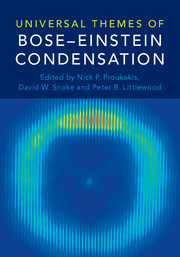Book contents
- Frontmatter
- Contents
- Foreword
- Preface
- Part I Introduction
- Part II General Topics
- Editorial Notes
- 5 The Question of Spontaneous Symmetry Breaking in Condensates
- 6 Effects of Interactions on Bose-Einstein Condensation
- 7 Formation of Bose-Einstein Condensates
- 8 Quenches, Relaxation, and Prethermalization in an Isolated Quantum System
- 9 Ultracold Gases with Intrinsic Scale Invariance
- 10 Berezinskii-Kosterlitz-Thouless Phase of a Driven-Dissipative Condensate
- 11 Superfluidity and Phase Correlations of Driven Dissipative Condensates
- 12 BEC to BCS Crossover from Superconductors to Polaritons
- Part III Condensates in Atomic Physics
- Part IV Condensates in Condensed Matter Physics
- Part V Condensates in Astrophysics and Cosmology
- Universal Bose-Einstein Condensation Workshop
- Contributors
- Index
- References
10 - Berezinskii-Kosterlitz-Thouless Phase of a Driven-Dissipative Condensate
from Part II - General Topics
Published online by Cambridge University Press: 18 May 2017
- Frontmatter
- Contents
- Foreword
- Preface
- Part I Introduction
- Part II General Topics
- Editorial Notes
- 5 The Question of Spontaneous Symmetry Breaking in Condensates
- 6 Effects of Interactions on Bose-Einstein Condensation
- 7 Formation of Bose-Einstein Condensates
- 8 Quenches, Relaxation, and Prethermalization in an Isolated Quantum System
- 9 Ultracold Gases with Intrinsic Scale Invariance
- 10 Berezinskii-Kosterlitz-Thouless Phase of a Driven-Dissipative Condensate
- 11 Superfluidity and Phase Correlations of Driven Dissipative Condensates
- 12 BEC to BCS Crossover from Superconductors to Polaritons
- Part III Condensates in Atomic Physics
- Part IV Condensates in Condensed Matter Physics
- Part V Condensates in Astrophysics and Cosmology
- Universal Bose-Einstein Condensation Workshop
- Contributors
- Index
- References
Summary
Microcavity exciton-polaritons are interacting Bose particles which are confined in a two-dimensional (2D) system suitable for studying coherence properties in an inherently nonequilibrium condition. A primary question of interest here is whether a true long-range order exists among the 2D exciton-polaritons in a driven open system. We give an overview of theoretical and experimental works concerning this question, and we summarize the current understanding of coherence properties in the context of Berezinskii-Kosterlitz-Thouless transition.
Introduction
Strange but striking phenomena, which are accessed by advanced experimental techniques, become a fuel to stimulate both experimental and theoretical research. Experimentalists concoct new tools for sophisticated measurements, and theorists establish models in order to explain the surprising observation, ultimately expanding our knowledge boundary. A classic example of the seed to the knowledge expansion is the feature of abnormally high heat conductivity in liquid helium reported by Kapitza and Allen's group, who used cryogenic liquefaction techniques in 1938 [1, 2]. It is a precursor to a “resistance-less flow” a new phase of matter, coined as superfluidity in the He-II phase. Immediately after this discovery, London conceived a brilliant insight between superfluidity and Bose-Einstein condensation (BEC) of noninteracting ideal Bose gases [3], which has led to establish the concept of coherence as off-diagonal long-range order emerging in the exotic states of matter. Since then, it is one of the core themes in equilibrium Bose systems to elucidate the intimate link of superfluidity and BEC in natural and artificial materials, where dimensionality and interaction play a crucial role in determining the system phase.
Let us consider the noninteracting ideal Bose gases whose particle number N is fixed in a three-dimensional box with a volume V. According to the Bose-Einstein statistics, the average occupation number Ni in the state i with energy is given by with the chemical potential and a temperature parameter (Boltzmann constant kB and temperature T). For the positive real number of is restricted to be smaller than, and the ground-state particle number N0 diverges as approaches the lowest energy. Its thermodynamic phase transition refers to BEC, in which the macroscopic occupation in the ground state is represented by the classical field operator, where is the particle density and is the phase.
- Type
- Chapter
- Information
- Universal Themes of Bose-Einstein Condensation , pp. 187 - 204Publisher: Cambridge University PressPrint publication year: 2017
References
- 1
- Cited by

